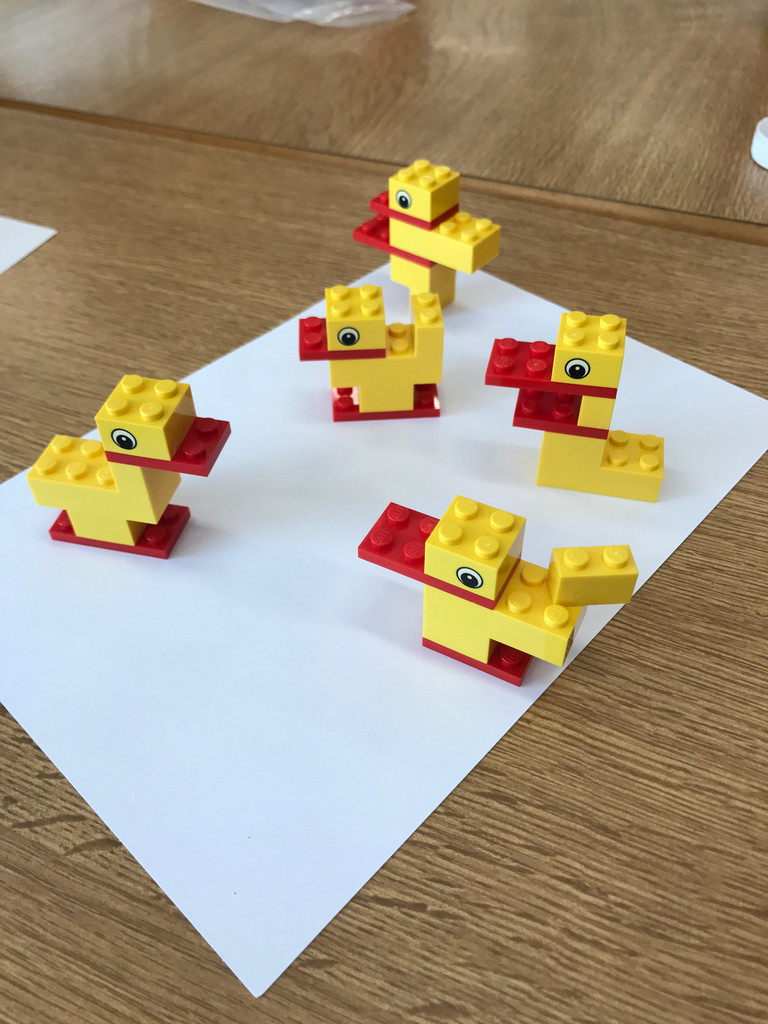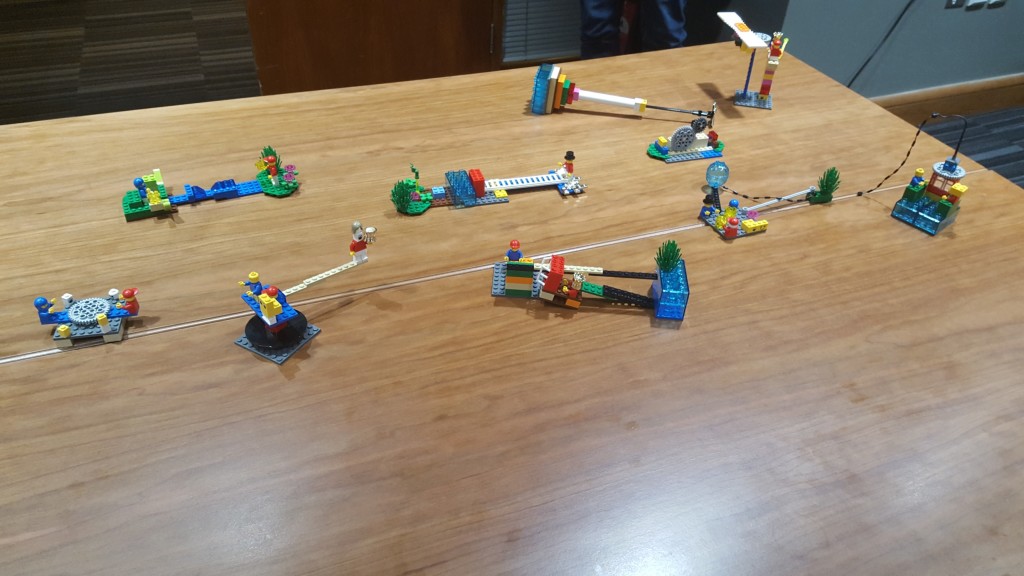Let’s Play. Seriously. Let’s Play.
As some of you might know, I recently got my certification as a Facilitator in the LEGO® SERIOUS PLAY® method. It was a marvelous experience in London, with Robert Rasmussen himself, alongside a bunch of incredibly talented and eclectic individuals from all around the world. It has been extremely interesting and, to me, these kind of training […]
As some of you might know, I recently got my certification as a Facilitator in the LEGO® SERIOUS PLAY® method.
It was a marvelous experience in London, with Robert Rasmussen himself, alongside a bunch of incredibly talented and eclectic individuals from all around the world. It has been extremely interesting and, to me, these kind of training is highly invigorating, I always come home full of new energy and ideas and thoughts on how to implement what I learned.
It is odd that my training programs are involving more and more techniques borrowed from the gaming world, or is it? It might be as well the (bad) influence my (very good) compeer Gabriele Gallo is having on me. And if you don’t know why, it means I haven’t talked enough about our book (see here) or about the class we’ll hold in Las Vegas next November (see here). Yes, what I’m trying to tell you is…
Good.
Now, let’s get back to LEGO® and what I did in London, shall we?
It’s all based on the concept of “Serious Play”, which I’m not sure my fellow Gabriele would approve. The page of Wikipedia on the subject is extremely well done and highly structured, therefore I’ll make an exception to my usual ways of proceeding and I’ll quote that as a source.
Serious Play is an array of playful inquiry and innovation methods that serve as vehicles for complex problem-solving, typically in work-related contexts.
The term was made popular by Michael Schrage of MIT in his popular 2000 book Serious Play: How the World’s Best Companies Simulate to Innovate.
Successful innovation demands more than a good strategic plan; it requires creative improvisation. Much of the “serious play” that leads to breakthrough innovations is increasingly linked to experiments with models, prototypes, and simulations. As digital technology makes prototyping more cost-effective, serious play will soon lie at the heart of all innovation strategies, influencing how businesses define themselves and their markets.
Of course the idea highly interested me because its theorization is deeply linked to the concept of building models.
In Serious Play, Schrage argues that the real value in building models comes less from the help they offer with troubleshooting and problem solving than from the insights they reveal about the organization itself. Technological models can actually change us–improving the way we communicate, collaborate, learn, and innovate.
Now, lots of things can be said about the LEGO Company, but you can’t argue that they don’t take modelling (or play) very seriously. I take modelling very seriously too, and I own a bunch of LEGO.

Robert Rasmussen was one of the guys developing the method back in 2001, when the head of LEGO was deeply unsatisfied with how his teams were working, and in his own words the Method is not a religion… but it’s close. It’s a highly structured set of activities and techniques based on a “bunch of science” you may find at this page. These are the two main key concepts.
1. Constructionism: think with your hands
Constructionist learning is a theory by MIT researcher Seymour Papert. One of the pioneers of artificial intelligence and co-inventor of Logo programming language alongside Wally Feurzeig and Cynthia Solomon, Papert was a mathematician, computer scientist, and educator, who advocated a student-centered learning based on discovery and on the construction of models, both mental and physical, which would help the learner to understand the world around him and to unlock more knowledge based on knowledge already acquired. The building of models encourages to create connections between different ideas and concepts coming from different areas of knowledge.


The building of physical models, moreover, helps towards a more effective learning. His theories were organically presented in a proposal to the National Science Foundation titled Constructionism: A New Opportunity for Elementary Science Education.
…we take a view of learning as a reconstruction rather than as a transmission of knowledge. Then we extend the idea of manipulative materials to the idea that learning is most effective when part of an activity the learner experiences as constructing a meaningful product.
In the 1980s, LEGO began founding Papert’s research group and eventually launched its LEGO Mindstorms Robotics Invention System (1998). The same research led, eventually, to the LEGO® SERIOUS PLAY® method.

2. Constructivism: don’t think you can teach them
On the other hand (sorry, I had to) we have the older theory of Constructivism, developed by Swiss philosopher Jean Piaget. Constructionism is firmly based on this concept as well.
In his famous experiment featuring a child and three glasses, he aims to demonstrate that people can’t actually learn anything unless their experience has created a framework into which this new knowledge can fit. It doesn’t matter if you have the most elaborate of demos: you need to make this people receptive before you can teach them. The whole concept of “facilitating” (instead of coaching or consulting) comes from this assumption: you need to foster what people already have inside of them.
Might be that I’m fixated: I couldn’t help but thinking how relevant this is when teaching BIM. If you’ve been around for a while, you know by now that you actually can’t convince anyone of the benefits. It needs to come from people’s actual needs.
Alongside these principles, there are other key features I would like to share.
1. Free the Penguin
One of the underlying principle of LEGO® SERIOUS PLAY® is that in a regular meeting there’s a 20% of people that contribute for 80% of the total value both in terms of time and ideas. This is called the 20-80 phenomenon.
The goal of the method is to allow everybody to contribute, ideally using all the same amount of time. This constitues of two steps:
1. You build, individually. This allows the participants to think, both with his mind and his hands, and this invaluable time never gets provided in any meeting. People speak without having the proper time to think. We can all see the results.
2. You share, in a safe environment. You basically tell everybody what you built and what is the thought around it. The bricks allow for a situation where everybody has the same tools and the facilitator needs to ensure that everybody feels safe to build and to share. This doesn’t mean that people are allowed not to build and share. On the contrary, everybody needs to participate. If they don’t, everybody else will feel vulnerable and will suddenly “lean back”.
3. You discuss, based on the model. Every discussion is welcome but the goal of the method is to avoid discussion from going personal, so every discussion must be about the model. If something is in the model, it means it’s valid. If the builder says something in the model means something, then it means that. Simple.
The goal is to free trapped thoughts and ideas that people will not share or won’t even know they possess.
2. Duck!
Another very important principle is the contemporaneity of building. Since everybody start building in the same moment and they have a limited time, they tend to concentrate more in what they are doing and less on what other people are doing.
In a traditional meeting, the first person to take the lead on the discussion might influence others. Power struggles and leadership issues come into play.
The LEGO® SERIOUS PLAY® method encourages to explore different views and believes in the fact that all meetings can take advantage of everyone contributing. Each point of view is unique and valuable. This is well represented by the Duck experiment: given a limited time and the same amount of bricks (a very little amount), a number of X participants will come out with X different ducks, each of them unique and special. This is a fantastic demonstration of the power of building vs. just talking.

3. Building is cool!
“…and if you don’t know what to build – Robert used to tell us – just build a cool model”.

This is one of the most important principles I take back from the workshop. If you feel like you are stuck with something, don’t “have a meeting with yourself” (another of Robert’s sayings): just start doing something that makes you feel good and ideas will come while you work.



When to use LSP
The method can be used in a whole set of situations. From the LEGO website, these are the main situations in which it’s beneficial to apply LSP.
- The subject is complex and multifaceted and there is a need to grasp the bigger picture, find connections and explore options and potential solutions.
I found that the connection part was the most interesting, although it takes a longer workshop to get that deep into the subject.
A practical example: provided we built an ecosystem of core values for our organization, we placed them into a so-called landscape and we connected them together in a way that makes sense, what happens to the whole picture when one of the elements is compromised? You’ll be amazed.

- It is important to reach decisions which everyone commits to and honors after the meeting even though he or she does not agree 100%
The main idea of building something individually and sharing it is mutual understanding. You also have a technique in which you encourage people to take their own models apart and build a shared model with elements salvaged from their own view. Since it’s something they built together, they will be committed to the decision and they won’t forget what they decided to do, because the model creates a strong emotional connection also at a memory level.

- Asking each team member or participant the same question results in substantially different answers.
The duck, the duck!
Seriously, if you were unimpressed with the duck example, ask people from the same corporation to build what they believe is their corporate identity now and this might get a little more interesting.

- Everyone in the group has an interest or stake in what is on the agenda
Tricky, this one. If people are not committed it’s difficult to bring them to the table, but LEGO helps, seriously, because everybody likes to loosen up and have his voice heard.
- You want to use the time efficiently
Ha! Isn’t playing with LEGO a waste of time? Did I hear anybody saying that? Well, clearly you have never had a 4-hours meeting about whether we should or should not force the Common Data Environment on top of the Consultants.
Traditional meetings might result in a waste of time.
This kind of workshop provides you with tangible results, increased self-consciousness and a solution that everybody remembers and commits to. Can you say the same about your workshops, darling?
So, this is pretty much it.
As you might have guessed, I am electrified. I hope I managed to arise your interest in the subject. And should you be particularly interested… well, contact me. We have a network of facilitators around the world. Book a workshop for your tricky subjects and let’s build something cool.







Great, thank you very much for your articles. I’ve read you for a long time. Thank you.